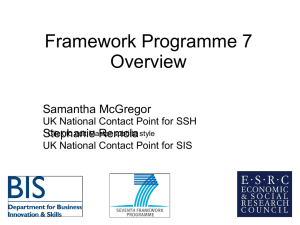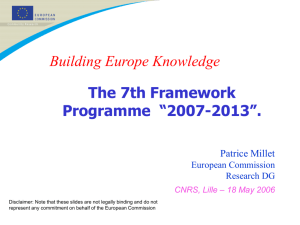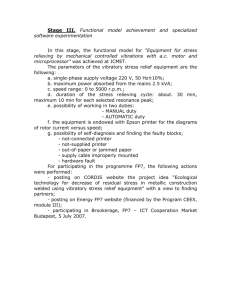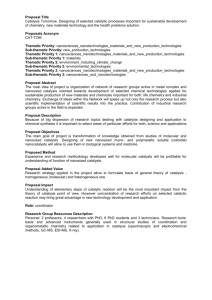Framework Programme
advertisement
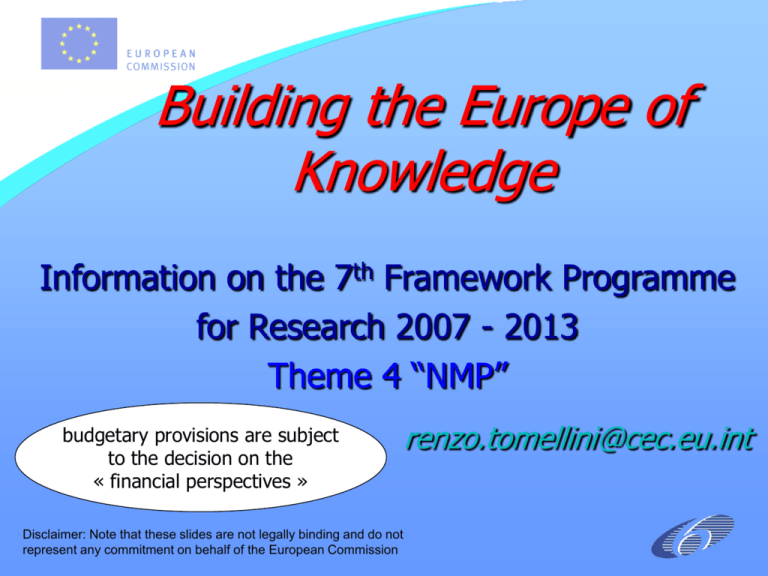
Building the Europe of Knowledge Information on the 7th Framework Programme for Research 2007 - 2013 Theme 4 “NMP” budgetary provisions are subject to the decision on the « financial perspectives » Disclaimer: Note that these slides are not legally binding and do not represent any commitment on behalf of the European Commission renzo.tomellini@cec.eu.int Lisbon strategy Research Growth and Jobs Education Innovation S&T contributes to the Lisbon objectives: economic growth, employment creation, environmental protection, social challenges: fight poverty, improve human health and quality of life (GSM, remote working, safe roads, etc.) R&D – European weaknesses R&D intensity (% of GDP) EU-25 US Japan 1.97 2.59 3.12 55.9 63.1 73.9 5.5 9.0 9.7 38.3 31.1 9.6 639 809 569 31.5 34.3 26.9 30.5 53.1 92.6 19.7 28.5 26.5 16.7 20.0 10.6 (3) Share of R&D financed by industry (%) (2) Researchers per thousand labour force (FTE) Share of world scientific publications (%) (3) Scientific publications per million population Share of world triadic patents (%) (3) (3) (1) Triadic patents per million population (1) High-tech exports as a share of total manufacturing exports (%) (3) Share of world high-tech exports (%) Note: (1) 2000 data (2) (2) 2002 data (3) 2003 data Why research at European level? Pooling resources Excellence in research Assembling critical mass, Enabling “big science”, Leveraging private investment Supporting research careers and mobility of researchers, Creating world class centres of excellence, EU level competition to increase quality and creativity Integration of research Addressing pan-European challenges, Coordinating national and regional policies, Conducting comparative research at EU level, Disseminating research results more widely FPs: significant impacts on S&T and the economy Economic benefits €1 (research) at European level (long-run, econometric models) Reduced commercial risk €4-7 increased turnover and profitability enhanced productivity and market share Innovative performance Enterprises participating in FP: tend to be more innovative more likely to patent engage in innovative co-operation with other firms and universities FPs: strong impact on the integration of the ERA Concentration of research efforts through larger projects with critical mass Average number of participants per project: 4.7 (FP2) 14 (FP6) Average number of MS per project: 3 (FP2) 6.7 (FP6) Average EU funding per project: €1.2 million (FP2) €4.6 million (FP6) Top-level scientists: ERA more attractive to researchers worldwide. e.g. six Nobel prize winners involved in FP6 fundamental genomics projects Number of participating countries from across the world: 30 (FP2) 140 (FP5) Projected FP7 economic impacts (by 2030, as compared to a business-as-usual scenario) Discontinuing the FP and no national compensation Doubling funding under FP7, moderate growth thereafter Doubling funding under FP7, rapid growth thereafter Extra GDP (%) - 0.84 + 0.45 + 0.96 Extra GDP when taking account of increases over time in the quality of products (%) - 1.31 + 0.69 + 1.66 - 840 000 + 418 000 + 925 000 - 87 000 + 40 000 + 214 000 - 0.089 + 0.059 + 0.228 -1.92 +0.64 +1.57 + 1.43 - 0.27 - 0.88 Indicators Extra employment (#) Extra jobs in research (#) Increase in R&D intensity (% of GDP) Change in exports to outside Europe (%) Change in imports from outside Europe (%) Preparation of a Framework Programme Three key documents: The Framework Programme Proposals Specific Programmes Rules for Participation all documents are published on CORDIS (addresses are on the last slide) Framework Programme 7 Sets out the structure, the key research priorities and the implementation procedure Co-decision procedure (Art. 251 EC) Negotiation within the Council: Working Group, Coreper, Council Negotiation within the European Parliament: ITRE (Buzek), plenary Opinions by CoR and EESC Specific Programmes Provides further insight into the research priorities, implementation procedures and novel content Approval procedure (Art. 252 EC) i.e. decided by Council following opinion of European Parliament FP7 - separate EP-rapporteur for each SP Negotiation within the Council: Working Group, Coreper, Council Opinions by EESC Rules for Participation Commission proposal in December 2005 Sets out the legal, financial and IP provisions for participants Co-decision procedure (Art. 251 EC) Negotiation within the Council: Working Group, Coreper, Council Negotiation within the European Parliament: ITRE, plenary Opinions by CoR and EESC Example of co-decision procedure Commission opinion on EP amendments Direct approval if agreement with EP New ! Consultations (online etc) Council 2 4 5 (within 3 months) Commission Proposal Opinion Common position Amendments (approval within 6 weeks) Conciliation: joint text Adoption (absolute majority of members) FP evaluations European Research Advisory Board (approval within 6 weeks) (within 3 months) 1 3 4 European Parliament Council decides by qualified majority except on EP amendments not approved by the Commission 5 Specific Programmes (FP7 2007 – 2013) Cooperation – Collaborative research Ideas – Frontier Research People – Human Potential Capacities – Research Capacity + JRC (non-nuclear) JRC (nuclear) Euratom Cooperation – Collaborative research 9 Thematic Priorities 1. 2. 3. 4. 5. 6. 7. 8. 9. + Health Food, agriculture and biotechnology Information and communication technologies Nanosciences, nanotechnologies, materials and new production technologies Energy Environment (including climate change) Transport (including aeronautics) Socio-economic sciences and the humanities Security and space Euratom: Fusion energy research, nuclear fission and radiation protection Cooperation – Collaborative research Under each theme there will be sufficient flexibility to address both Emerging needs and Unforeseen policy needs Dissemination of knowledge and transfer of results will be supported in all thematic areas Support will be implemented across all themes through: Collaborative research (Collaborative projects; Networks of Excellence; Coordination/support actions) Joint Technology Initiatives Coordination of non-Community research programmes (ERA-NET; ERA-NET+; Article 169) International Cooperation Ideas – European Research Council Frontier research Support to individual teams, to promote excellence through Europewide competition Dedicated implementation structure (Executive Agency) Independent scientific governance (Scientific Council) European Research Council Independent; respected personalities, reflecting the full scope of European research Responsible for scientific strategy, oversight and guarantee of quality in scientific decision-making Prior to FP7 decision, would act as advisory body in the development of the “Ideas” programme People – Human Potential Initial training of researchers Marie Curie Networks Life-long training and career development Individual Fellowships Co-financing of regional/national/international programmes Industry-academia pathways and partnerships Industry-Academia Scheme International dimension Outgoing International Fellowships; Incoming International Fellowships International Cooperation Scheme; Reintegration grants Specific actions Excellence awards Capacities – Research Capacity 1. 2. 3. 4. 5. 6. Research Infrastructures Research for the benefit of SMEs Regions of Knowledge Research Potential Science in Society Activities of International Cooperation 3. Regions of Knowledge Development of regional ‘research-driven clusters’ Two objectives for European regions: Strengthen their capacity for investing in RTD and carrying out research activities Maximising their potential for a successful involvement of their operators in European research projects Regions of Knowledge Activities: Bring together regional research actors Universities Research centres Industry Public authorities Joint analysis of research agendas of regional clusters Develop deployment strategies, including mentoring Regions of Knowledge Expected outcomes: Improved research networking Better access to R&D funding sources Better integration of research actors in regional economies Close relationship with other related EU policies Synergies with regional policy Convergence and Outermost (RUP) regions R&D and Innovation, top priorities in the New Structural Funds In new Objectives, STRF back Lisbon Strategy by Strengthening R&D capacity in less-advanced regions Ensuring fruits of research spread to all regions Synergy with FP7 Not necessarily co-funding same activities, but … Complementary funding where possible EURATOM Framework Programme Objectives Nuclear fission & radiation protection developing safer management of long-lived radioactive waste promoting safer, more resource-efficient and competitive exploitation of nuclear energy ensuring a robust and socially acceptable system of protection of man and the environment against the effects of ionising radiation. Fusion energy research ITER creation of prototype reactors for power stations which are safe, sustainable, environmentally responsible, and economically viable Specific Programme proposals Proposals for 7 Specific Programmes presented on 21 September 2005 More details on: Thematic content and implementation Integration of cross cutting aspects Descriptions of the 6 Joint Technology Initiatives and 4 Article 169 Initiatives Establishment of the European Research Council, and respective roles of the Scientific Council, Implementation structure, and Commission. Grant to the European Investment Bank to establish the Risk Sharing Finance Facility Funding Schemes: General Principles FP6 emphasised new instruments to structure research efforts and overcome fragmentation FP7 proposes flexible use of funding schemes, either alone or in combination, to fund actions that address scientific and technological objectives throughout the Framework Programme. Funding Schemes: General Principles (2) The decisions for work programmes and calls for proposals will mention, as and when appropriate: The type(s) of scheme(s) used to fund different actions; The participants (such as research organisations, universities, industry, public authorities) which can benefit from it; The types of activities (research, development, demonstration, training, dissemination, transfer of knowledge and other related activities) which can be funded through each of them. Where different funding schemes can be used, work programmes may specify the funding scheme to be used for each element of the call for proposals What’s new in the EC proposal? Main new elements compared to FP6: Duration increased from 5 to 7 years Original proposal: annual budget doubled, from €5 billion to €10 billion Basic research New structure: cooperation, ideas, people, capacities Flexible funding schemes Joint Technology Initiatives Simpler procedures Logistical and administrative tasks external structures FP7 – what’s new? Not “new” but evolution (continuity) of successful FP6 elements: Themes for collaborative research (but with some new areas and greater flexibility) Marie Curie actions (but with new emphasis, e.g. international aspects and industry-academia mobility) SME specific actions (but with major increase in budget) Funding schemes (but with improvements) FP7 – what’s new? …and major new approaches Joint Technology Initiatives Coordination of National Research Programmes (Art. 169) New research infrastructures Simplification European Research Council Research Potential scheme to exploit research excellence in “convergence regions” Risk sharing finance facility (increasing the availability of European Investment Bank loans) Management The proposed doubled FP budget does not increase Commission staff Need new structures to manage the increase “Externalise” part of the FP management to executive agencies for the first time Policy-related tasks remain with Commission European Technology Platforms and JTIs Industrial character : Bottom-Up Approach with Industry in Lead Wide Stakeholder Involvement Flexibility: No “One Size Fits All” EU Role: Facilitating and Guiding but not Leading or Owning Majority of Strategic Research Agendas, where Appropriate, Taken into Account in Thematic Priorities of FP7 Minority of Strategic Research Agendas Identified through Dialogue with Industry as Potential “Joint Technology Initiatives” Joint Technology Initiatives Firmly Anchored in Themes of the Cooperation Programme In Fields of Major European Public Interest Six Fields Envisaged at this Stage Innovative medicines Nanoelectronics Embedded systems Aeronautics and air traffic management Hydrogen and fuel cells Global monitoring for environment and security Other Fields Possible Subsequently Co-ordination of nonCommunity research Programmes (Art. 169 EC) Subject to co-decision procedure (Art. 215 EC) Four areas are proposed: Baltic Sea Research Ambient Assisted Living Metrology Research Performing SMEs New research infrastructures Construction of new infrastructures and major updates of existing ones Based on work of ESFRI On basis of Article 171 when relevant Design and foresight studies Bottom-up approach Exploratory awards and feasibility studies for new infrastructures Simplification of procedures Measures proposed: Rationalising the funding schemes simpler set of funding instruments Avoiding red-tape! less bureaucratic and more user-friendly languages Reducing number and size of documents number of requests to participants Risk-sharing finance facility: Objectives and added value Innovative financing mechanism Improve access to EIB loan finance Foster increased private investment in research Risk-sharing with EIB to allow Larger volume of EIB lending Financing of riskier projects by EIB Leverage effect extra lending by EIB = 34 times EU funds allocated Benefit from EIB experience and management FP7 Timetable June 2004 Communication on the future of EU research policy April 2005 Commission proposals for FP7 decision, extended Impact Assessment Sept. 2005 Proposals for Specific Programmes Nov. 2005 Partial general political agreement in the Competitiveness Council Dec. 2005 Proposals for Rules for Participation and Dissemination Next steps (indicative): June 2006 Common Position of the Council July 2006 Second reading / European Parliament Oct./Nov. 2006 Adoption Dec. 2006 First calls under FP 7 Budgets of the EU FPs 1984-2013 possible scenario NB: Budgets in current prices. Source: Annual Report 2003, plus FP7 proposal FP7 budget (€ billion, current prices) original Commission proposal Framework Programme 7: Objectives and activities original Commission proposal FP7 EC (cash prices) COOPERATION Themes Health Biotech, Food, Agriculture Information Society Nano, Materials, Production Energy Collaborative Research 8.317 2.455 12.670 4.832 2.931 IDEAS European Research Council PEOPLE Marie Curie Actions R e s e a rc h Inf ra s t ruc t ure s R e s e a rc h f o r, a nd by, SM Es R e gio ns o f Kno wle dge R e s e a rc h P o t e nt ia l SocioSpace and Environment Transport economic Security Research 2.535 5.940 792 3.960 44.432 11.862 7.129 S c ie nc e in S o c ie t y Int e rna t io na l C o - o pe ra t io n CAPACITIES 7.486 3.961 1.901 158 554 554 358 JRC (EC) 1.817 Total 72.726 Financial Perspectives 2007 - 2013 The „financial perspectives“ are a tool for multi-annual budgeting in the EU Final decisions on the FP7 are thus subject to the „financial perspectives“ The Commission will put forward a revised proposal for the framework programme taking into account „the moneys available“ Relationship between texts Framework Programme Rules of Participation (Art 167) SP: Capacities SP: People SP: Ideas Simplified contracts SP: Cooperation Themes: Work Programmes Information packs, manuals for participants... Theme 4 will have its own work programme Theme 4: Nanosciences, nanotechnologies, materials and new production technologies FP7 Total Budget 2007-13 (proposed) : 72 726 mio € - Theme 4 budget: 4 832 mio € original Commission proposal Theme 4: Nanosciences, nanotechnologies, materials and new production technologies Overall objective : improve the competitiveness of EU industry (including SMEs) and ensure its transformation through: the effective transition from a resource-based to knowledge-based industry generation of new breakthrough, applicable, knowledge strengthening EU leadership in nano, materials and production technologies emphasis on integrating different technologies and disciplines across many sectors … Same messages as in FP 6 Importance of Technology Platforms to help establish common research priorities Theme 4: Nanosciences, nanotechnologies, materials and new production technologies Four activities: 1. Nanosciences and nanotechnologies 2. Materials 3. New production 4. Integration of technologies for industrial applications …very good continuity with « NMP » activities in FP 6 !! The Work Programme will be developed during 2006… More S&T details; Funding schemes (« instruments ») preferred; Indicative budgets for calls; Call road map … Theme 4: Nanosciences, nanotechnologies, materials and new production technologies 1. Nanosciences and nanotechnologies Objective: increase and support the take up of knowledge generated in this revolutionary field for all industrial sectors Topics include: interface and size dependent phenomena; materials properties at nano-scale; self assembly; metrology; new concepts and approaches; impacts on health and safety; convergence of emerging technologies Theme 4: Nanosciences, nanotechnologies, materials and new production technologies 2. Materials Objective: generate new knowledge to enable new industrial products and processes to be achieved, exploiting the potential of interdisciplinary approaches in materials research. Topics include: high performance, sustainable and knowledge-based materials; design and simulation; nano-, bio- and hybrid materials and their processing; chemical technologies and materials processing industries Theme 4: Nanosciences, nanotechnologies, materials and new production technologies 3. New production Objective: create continuously innovating production capabilities to achieve leadership in industrial products & processes in the global marketplace. Topics include: Knowledge-intensive production; new paradigms for emerging industrial needs; adaptive, networked and knowledge-based production; convergence of technologies for next generation of high value-added products (nano, bio, info, cognitive..) Theme 4: Nanosciences, nanotechnologies, materials and new production technologies 4. Integration of technologies for industrial applications Objective: accelerate the rate of industrial transformation by exploiting the application potential of new generic technologies. Topics include: Integration of nano, materials and production technologies in sectoral and cross-sectoral applications (e.g. health, construction, transport, energy, chemistry, environment, textiles & clothing, pulp & paper, mechanical engineering,…) Theme 4: Nanosciences, nanotechnologies, materials and new production technologies Technology Platforms related to Theme 4: Nano-electronics (ENIAC); Nanomedicine; Sustainable Chemistry; Steel; Future Textiles & Clothing; Manufacturing Technologies; Construction Technology; Industrial Safety; Hydrogen; Photovoltaics… Possible special features of Theme 4: Theme 4: Nanosciences, nanotechnologies, materials and new production technologies No pre-set budget split between sub-areas Continue with 2-Stage submission ( i.e. FP 6 – IPs, NoEs) IP-SMEs – a form of dedicated “collaborative project” Research projects at “frontiers of knowledge” still NoEs – Only where integration is needed More Joint Calls (e.g. with Theme 3 – IST); More Coordinated Calls (e.g. with Third Countries and/or other Themes within SP 1 and JTIs); International Cooperation: different according to countries (DEV, MED, NIS,…; ‘industrialised’ – IMS, USA, Jap,…) Possible special features of Theme 4: Theme 4: Nanosciences, nanotechnologies, materials and new production technologies Policy Needs and Road Mapping - Coordination/ support actions as well as ERA-NET Synergies with Technology Platforms and JTIs SRAs input towards RTD priorities of WP Synergies with EUREKA and COST Topics, implementation modalities, type of calls, detailed WP contents, evaluation procedures,…: key role for Programme Committee and other advisory bodies. NCPs remain crucial for potential participants! Funding Schemes 1. Collaborative projects rate or Lump sum ) (Cost basis: Eligible, Flat Trans-national consortia New knowledge, technology, products or common resources for research Size, scope and internal organisation of projects can vary 2. Networks of Excellence ONLY !) (N.B. Lump Sum Funding Joint programmes by organisations integrating activities in a given field Longer term co-operation Commitment to integrate resources Funding Schemes continued 3. Coordination and support actions networking, exchanges, trans-national access to research infrastructures, studies, conferences, etc. 4.Individual projects (Basic research via ERC…) 5. Training and career of researchers 6. Research for the benefit of specific groups (in particular SMEs such as CRAFT Feasibility Awards are reintroduced ) The Commission proposal for the Rules of Participation in the 7th RTD Framework Programme (as adopted on 23.12.05) General aspects The rules, in particular the introductory memorandum, are very much focussed on the aspects of simplification, e.g.: • electronic submission will be rule • internal rules for financial viability checks • no more collective financial responsibility guarantee fund ? No more bank guarantees ? • Programme Committee(s) shall become more strategic • establishment of help desks and clearing houses (responsibilities?) Proposal preparation “Public bodies” are defined with reference to national law “Third country” definition is general = not a Member State. “Associated State” = not a Member State but paying into FP7 Minimum Participation: 3 independent participants from 3 different Member States or Associated countries Proposal Preparation Specific: Frontier research actions (ERC): – at least one legal entity established in a Member State or Associated country Coordination and support actions and actions in favour of training and career development of researchers – minimum of one legal entity (no limit on place of establishment) International cooperation projects: partner countries in parity with Member or Associated States, i.e. minimum is 4 participants Proposal Evaluation • evaluation criteria not specified in the Participation Rules, but in the Specific Programmes and annual Work Programmes (diversity vs. harmonisation) • no evaluation for some specific support actions • experts “only” with appropriate skills and knowledge; not “high-ranking” anymore • the list of experts will be published periodically per specific programme • two-stage evaluation mentioned as possibility, with specific rules to be established Implementation Model grant agreement to be drawn up: • identify whether and what part of the EC financial contribution is based on reimbursement of eligible costs, lump sums or flat rates; • Identify which changes in composition of the consortium require prior publication of a competitive call, and; • shall reflect the principles laid down in the European Charter for Researchers and the Code of Conduct for the Recruitment of Researchers • grant agreement comes into force upon signature by the coordinator and the Commission and applies to each participant that has acceded to it • Consortium agreements obligatory unless exempted by call for proposals Maximum funding rates • Research and technological activities – 50% of eligible costs except that for: • SMEs – 75% • Public bodies – 75% • Secondary and higher education establishments – 75% • Research organisations (non-profit) – 75% • • • • • Demonstration activities – 50% of eligible costs Other activities – 100% of eligible costs Frontier research actions – 100% Coordination and support actions – 100% Training and career development of researchers actions – 100% • Flat rate for overheads not specified in the Rules Financial management • Eligible costs definition remains unchanged •Average personnel costs may be used if consistent with above and do not differ significantly from actual • Audit certificates continued but rationalised • one audit certificate at the end of contract obligatory for grants with reimbursement of eligible costs • public bodies can use competent public officers Lump-sum for Networks of Excellence • A specific lump sum is identified for Networks of Excellence (NoEs) (unless otherwise provided for in work programme), calculated according to the number of researchers to be integrated (€ 23,500 / year / researcher) •Lump sums and flat rates do not require justification of eligible costs • Payments based on progress of integration measured by indicators (to be defined) Intellectual Property Rights • back to definition and use of the terms “background” and “foreground” for knowledge pre-existing to a project or knowledge generated therein. • no time limit anymore for notification on transfer of foreground. Commission not to notify unless specified in the contract • new: participants can define the background needed for project (“positive list”, p.m. FP6 = only “negative list”) THANK YOU for your attention http://cordis.europa.eu.int/fp7/ http://europa.eu.int/eurlex/lex/LexUriServ/site/en/com/2005/com2005_ 0705en01.pdf for the “rules of participation” http://cordis.europa.eu.int/nanotechnology
